Common Health Issues in Unneutered Cats
Unneutered cats, whether feral, stray, or owned, face a wide range of health risks and behavioral problems. In communities like Cattaraugus County, where community cat help is often managed through TNR programs and feral cat rescue, understanding these risks is crucial for both animal welfare and public health.
If you're a cat owner, volunteer, or advocate involved in humane stray cat control, this guide will explain the most common health problems in unneutered cats and why spaying and neutering is essential for a healthier, safer feline population.
Why Neutering and Spaying Matters
Before diving into the health concerns, it’s important to recognize that spaying and neutering cats is more than just birth control. It plays a vital role in:
Reducing overpopulation
Improving cat behavior
Preventing disease
Decreasing shelter euthanasia rates
Supporting community TNR efforts
Whether you're caring for a pet or involved in feral cat rescue, addressing the root cause—uncontrolled reproduction—is the foundation of humane cat care.
1. Reproductive System Infections (Pyometra)
One of the most dangerous health risks for unspayed female cats is pyometra, a life-threatening uterine infection. It can develop when hormonal changes after heat cycles lead to bacterial infections in the uterus.
Symptoms:
Lethargy
Vaginal discharge
Lack of appetite
Vomiting
Without immediate low-cost veterinary care, pyometra can be fatal. Spaying removes the risk entirely by eliminating the uterus and ovaries.

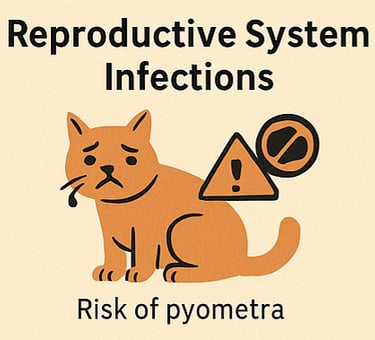
2. Testicular and Prostate Problems
Unneutered male cats are at increased risk for testicular tumors and prostate enlargement, which can affect urination and mobility. Although testicular cancer is rare in cats, it’s entirely preventable by neutering.
Benefits of neutering males:
Eliminates risk of testicular cancer
Reduces chances of prostate issues
Prevents painful abscesses from mating-related injuries
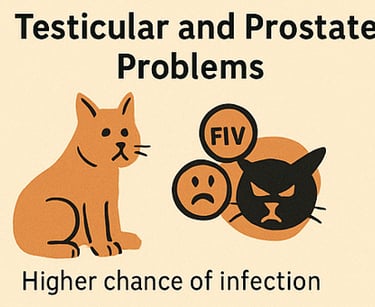

3. Feline Leukemia Virus (FeLV) and Feline Immunodeficiency Virus (FIV)
FeLV and FIV are highly contagious viruses that spread through mating, fighting, and shared food or water bowls. Unneutered cats, especially males, are more likely to roam and fight, putting them at higher risk of infection.
Symptoms:
Weak immune system
Chronic illness
Oral infections
Weight loss
Cancer in late stages
There is no cure for either virus, but TNR programs help reduce the spread by altering and vaccinating community cats.
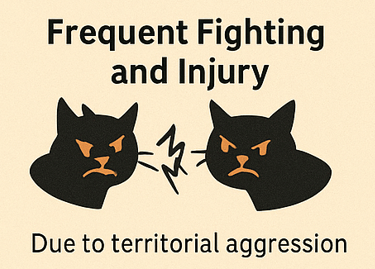

4. Frequent Fighting and Injury
Unneutered male cats are territorial and aggressive, often engaging in fights to defend their area or compete for mates. These altercations frequently result in:
Bite wounds
Abscesses
Eye injuries
Broken bones
These wounds can become infected and lead to serious health complications. Neutering significantly reduces aggressive behaviors and roaming tendencies.


5. Tumors and Mammary Cancer in Females
Unspayed female cats are more likely to develop mammary tumors, which are often malignant. The risk increases with each heat cycle and pregnancy. Spaying before the first heat reduces this risk by up to 90%.
In low-cost veterinary care programs in places like Cattaraugus County, early spay surgeries are promoted to prevent this common and deadly condition.
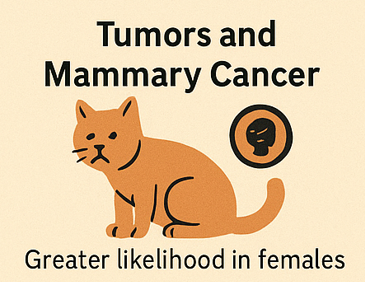

6. Parasite Infestations
Cats that are constantly outdoors and unaltered are more susceptible to parasites like:
Fleas and ticks
Ear mites
Worms (roundworms, tapeworms, hookworms)
These parasites can cause anemia, skin infections, digestive issues, and spread to other animals or humans (zoonotic transmission). Infected kittens are particularly vulnerable.
Feral cat rescue teams often treat trapped cats with flea/tick medication during TNR to reduce infestation rates.
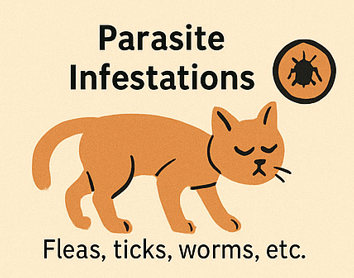

7. Malnutrition and Exhaustion from Repeated Breeding
Female cats can become pregnant multiple times per year, often nursing one litter while pregnant with another. This leads to:
Severe nutrient depletion
Weakened immune system
Shortened lifespan
For males, constant roaming in search of females increases stress and energy expenditure, often resulting in emaciation and illness. Neutering helps stabilize colonies and improves individual cat health.


8. Behavioral Issues and Public Nuisance
Though not a direct health issue, the behavioral problems associated with unneutered cats contribute to poor outcomes:
Spraying and marking territory with foul-smelling urine
Loud yowling during mating season
Roaming into traffic and dangerous areas
These behaviors increase the likelihood of accidents, injuries, or being removed by frustrated residents. Humane stray cat control depends on altering these behaviors through TNR.
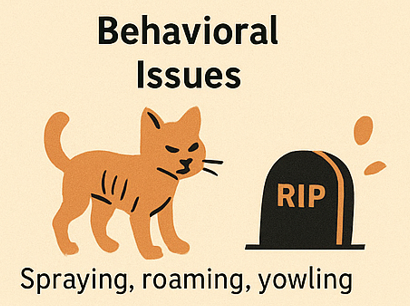

9. Increased Risk of Traffic Accidents
Unneutered cats roam more frequently and cover larger territories. This behavior increases the chances of:
Getting hit by vehicles
Becoming lost or trapped
Exposing themselves to harmful chemicals or predators
Spayed and neutered cats tend to stay closer to familiar areas, reducing exposure to danger.


10. Shorter Lifespan
Taken together, all of these health and behavioral issues contribute to a much shorter average lifespan for unneutered cats. By contrast, spayed or neutered cats live longer, healthier lives—whether they’re adopted into homes or remain outdoors as part of managed colonies.



How TNR and Low-Cost Vet Care Make a Difference
Many regions, including Cattaraugus County, offer low-cost veterinary care and TNR program support for community cats. These services include:
Free or affordable spay/neuter surgeries
Rabies and FVRCP vaccines
Parasite control
Ear-tipping for identification
These efforts are often carried out by feral cat rescue groups and volunteers who trap, transport, and return cats to their colonies safely.
How You Can Help
If you're concerned about unneutered cats in your neighborhood, here’s how you can get involved:
Start or support a TNR program in your area.
Volunteer with local feral cat rescue groups.
Donate to clinics or rescues offering low-cost veterinary care.
Educate your neighbors about the importance of cat spay and neuter.
Report stray colonies to community cat help services.
Even small actions—like trapping one cat or sharing a resource—can make a huge impact.
Final Thoughts
Unneutered cats face a wide range of preventable health issues that affect both individual well-being and the community at large. Whether you're dealing with feral colonies, neighborhood strays, or even your own pet, spaying and neutering is a life-saving solution.
Communities like Cattaraugus County are already taking steps through TNR programs, low-cost veterinary care, and humane stray cat control. By getting involved, you can be part of the solution—one cat at a time.
CATT COUNTY CAT NIPPERS

"I can't say enough good things about Catt County Cat Nippers. They helped a stray mother cat and her kittens in my neighborhood when no one else would. The volunteers were so kind and professional. Our community is better because of them."
Emily R., Local Resident

"Thanks to this amazing group, I found my best friend — a rescue cat named Oliver. The adoption process was smooth, and they really care about matching cats with the right homes. You can tell they love what they do."
Jason L., Cat Adopter


★★★★★
★★★★★
Subscribe to our website
Contact us :
Quick links :
Contact Us
© 2025 CATT COUNTY CAT NIPPERS All rights reserved.
